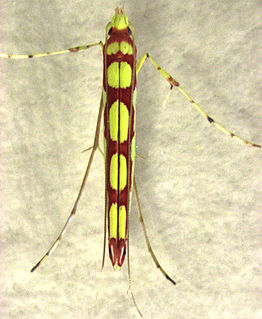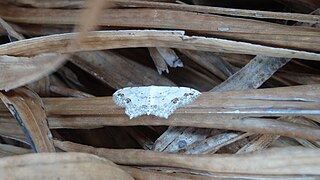
Caprona ransonnetii, commonly known as the golden angle, is a butterfly belonging to the family Hesperiidae. It was first described by Baron Cajetan von Felder in 1868.

Parnassius stoliczkanus, the Ladakh banded Apollo, is a rare high-altitude butterfly which is found in Central Asia. It is a member of the snow Apollo genus (Parnassius) of the swallowtail family. It is named after the naturalist and explorer Ferdinand Stoliczka.

Colotis amata, the small salmon Arab, is a small butterfly of the family Pieridae, that is, the yellows and whites. It is found in Africa and Asia.

Prosotas nora, the common lineblue, is a species of lycaenid butterfly found in Asia to Australia. The species was first described by Rudolf Felder in 1860.

Prosotas noreia, the white-tipped lineblue, is a species of lycaenid butterfly found in South Asia and Java.

Digama is a genus of moths in the family Erebidae described by Frederic Moore in 1858. It is distributed in South Africa, China, throughout India, Sri Lanka, Myanmar and Australia.
Migoplastis is a genus of moths in the subfamily Arctiinae first described by Rudolf Felder in 1868. They are confined to India's Nilgiri Mountains and to Sri Lanka.
Digama fasciata is a moth of the family Erebidae described by Arthur Gardiner Butler in 1877. It is found in north-western India and Sri Lanka.
Digama hearseyana is a moth of the family Erebidae described by Frederic Moore in 1859. It is found in India, Nepal, Sri Lanka and Pakistan. Two subspecies are recognized.

Macarostola miniella is a species of moth in the family Gracillariidae. It is endemic to New Zealand. This species is only found in the North Island and the adult moths have two different colour variations.

Ischyja manlia is a species of moth of the family Noctuidae first described by Pieter Cramer in 1776. It is found in the Indian subregion, Sri Lanka, Myanmar, Thailand, China, Okinawa, Sundaland, Sulawesi, Korea, the southern Moluccas, Australia (Queensland) and Palau. Adults pierce the skin of fruit to suck the juice.

Europlema desistaria is a species of moth of the family Uraniidae first described by Francis Walker in 1861. It is found in India, Sri Lanka, Myanmar, Thailand, Taiwan, Borneo, Sulawesi, Flores and Queensland.

Gesonia obeditalis is a species of moth of the family Noctuidae first described by Francis Walker in 1859. It is found from eastern Africa, the Seychelles, the Maldives and the Oriental tropics of India, Sri Lanka east to the Philippines, the Sula Islands and Australia. The adult moth has brown wings with a scalloped dark brown band near the margin. The hindwings are similar in pattern to the forewings but are a paler shade of brown.

Scopula pulchellata is a moth of the family Geometridae. It is found in the Indo-Australian tropics, from India, Sri Lanka to Taiwan and the Solomon Islands, as well as in Africa.

Eutelia geyeri is a moth of the family Noctuidae first described by Rudolf Felder and Alois Friedrich Rogenhofer in 1874. This species is found in India, Sri Lanka, China and Japan, as well as from Africa, where its presence had been reported from Lesotho and Seychelles.
Dolgoma angulifera is a moth of the family Erebidae first described by Felder in 1868. It is found in India, Sri Lanka and Thailand.
Dolgoma oblitterans is a moth of the family Erebidae first described by Rudolf Felder in 1868. It is found from the Himalayas, Sri Lanka to Yunnan. There is also a record from Tanzania.

Hypomecis separata is a species of moth of the family Geometridae. It was first described by Francis Walker in 1863. It is found in Sri Lanka, India, Java and Borneo.
Patissa lactealis is a moth in the family Crambidae. It was described by Cajetan Felder, Rudolf Felder and Alois Friedrich Rogenhofer in 1875. It is found in Sri Lanka.
Proleucinodes lucealis is a moth in the family Crambidae. It was described by Cajetan Felder, Rudolf Felder and Alois Friedrich Rogenhofer in 1875. It is found in French Guiana and Brazil.












